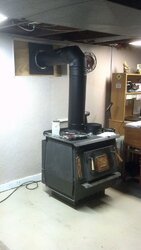Hi, I'm new to the forum and I wanted to ask you experts a Blaze King question.
I'm installing a ~1984 Blaze King KEJ-1101 in my basement that I got for free from a friend's parents. While reading the manual and looking over the stove, my dad and I wondered how the thermostat worked, so we took the cover off. When it is around the 1 setting the butterfly is closed, and as I turn the knob up, the butterfly falls partially open. My question is: Should the butterfly fall to wide open (90 degrees)? It cannot because it hits the screw that holds the assembly in the square air passage. My best estimate is that is opens about 10 degrees. We backed the screw out enough to let the butterfly rotate the full 90 degrees but when I turn the knob back to 1, it wont bring the butterfly shut again.
Should I cut the screw shorter to let the butterfly past or is it designed to stop it?
I'm installing a ~1984 Blaze King KEJ-1101 in my basement that I got for free from a friend's parents. While reading the manual and looking over the stove, my dad and I wondered how the thermostat worked, so we took the cover off. When it is around the 1 setting the butterfly is closed, and as I turn the knob up, the butterfly falls partially open. My question is: Should the butterfly fall to wide open (90 degrees)? It cannot because it hits the screw that holds the assembly in the square air passage. My best estimate is that is opens about 10 degrees. We backed the screw out enough to let the butterfly rotate the full 90 degrees but when I turn the knob back to 1, it wont bring the butterfly shut again.
Should I cut the screw shorter to let the butterfly past or is it designed to stop it?


